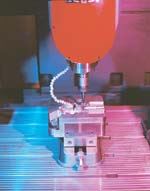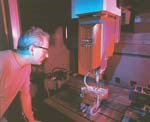Shop Owes Growth To CAD/CAM Versatility
This shop's programmer/operators, equipped with the most versatile CAD/CAM software they could choose, moved on to the tool path and cut more combinations of amazingly diverse parts, as a company confident of its ability to meet any of its customers' molding, machining or manufacturing needs.
Share






Hwacheon Machinery America, Inc.
Featured Content
View More

ECi Software Solutions, Inc.
Featured Content
View More
Autodesk, Inc.
Featured Content
View MoreA success story of expansion through diversification, 26-year-old Hofmann Tool Company has grown to employ more than 60 employees and, 5 years ago, moved into a new 40,000-square-foot manufacturing center. The company's capabilities include die cast dies and trim dies for customers across the automotive industry. For the commercial carpentry market, Hofmann adds stamping dies and progressive dies to its menu. Flexibility on the floor allows Hofmann to produce plastic molds for irrigation and household piping, and the company also builds ladder upsetting machines and heat shrinking machines for secondary operations and other specialized machines. Hofmann's floor plan and operator skills are at such a state-of-the-art level that the company simultaneously produces a diverse combination of parts using the whole spectrum of metalworking machines and techniques.
"Our operators are our programmers," says Chester Griffin, project manager. "Because we have so many different product lines, they need to be able to get a tool path running while they're getting the next design going." Mr. Griffin recalls that Hofmann's ability to do that began after reading a 1991 Modern Machine Shop article about Mastercam CAD/CAM software from CNC Software (Tolland, Connecticut) and purchased a seat of Level I Version 1. "Mastercam's ability to change and upgrade, and meet the challenges we had," Mr. Griffin continues, "was just the ticket for expanding our business."
In 1995 Mastercam became Hofmann's company-wide CAD/CAM software, the versatility and speed of which, according to Mr. Griffin, added 30 percent in new business the first year. "Because we do more with advanced CAM technology now, the same number of people can throughput almost a third more work."
Hofmann Tool now works with eight seats of Mastercam in 2D, 3D and Solids for mill, lathe and EDM production. The company also takes advantage of many of the add-ons that are available. A recent example includes the use of the RevQuick add-on to reverse-engineer trim dies for water pump castings for an automotive industry parts supplier. "Many auto parts are made from 2D prints—not 3D files," says Mr. Griffin, "so changes that developed over the years—modifying shapes to miss a line here, a hose there—are not able to be imported into our CAD/CAM program."
"Using RevQuick saved us the time we'd have had to spend measuring with the machine's tool and creating splines and other curves from those points, which, of course, Mastercam could have done," says Mr. Griffin. "But since the add-on imported and used the point cloud data so readily, we gained a turnaround advantage, which will help our sales as we bid on other jobs."
The pump housings measured approximately 10 inches by 8 inches by 4 inches. Programmer/operator Don Wortman aligned the work with the 4-inch dimension along the Z axis for a minimum depth of cut to machine the steel "nest," which would fixture the raw castings for trimming. He programmed a 2D roughing tool path, specifying a 2½-inch indexable carbide cutter at 15,000 rpm, 0.030 inch deep per pass with a 0.015 stepover at 300 ipm. "Mastercam's high speed machining capability saved us production time," Mr. Griffin observes, "without sacrificing the quality on which we've built Hofmann's reputation."
Mr. Wortman used the "leftover" function for a semi-finish pass with a ½ inch cutter to pick out any material in the tight corners of the nest, then ran successive "leftover" passes with ¼ inch and 1/8 inch cutters for a final finish inside and around the periphery of the nest. "The old way," Mr. Griffin says, "we'd have had to write the tool path again for each pass. ‘Leftover' takes care of that automatically."
Cutting the trim steel would complete the other half of the water pump trim die sets for each pump. The original laser scan provided the geometry for the tool path to wire the 1-inch trim steel to the periphery of the parts. The tool path was programmed to allow for a 2½ inches of material extension to accommodate the nuts and screws to attach the trim steel to the die shoe of the customer's presses. The trim dies were installed on the customer's presses adjacent to the their die-cast machines. As each part was finished in the die-casting process, it was manually flipped over into the Hofmann-machined nest, fixtured on the bed of the adjacent press. The press plunged, and the trim steel cut away the runners and overflows for a perfect profile.
Meanwhile, Hofmann programmer/operators, equipped with the most versatile CAD/CAM software they could choose, moved on to the tool path and cut more combinations of amazingly diverse parts, as a company confident of its ability to meet any of its customers' molding, machining or manufacturing needs. While Hofmann is hardly unique in its use of Mastercam, it has stretched—and continues to stretch—its capabilities by pushing the envelope. There is support for even the most entrepreneurial spirits to be limited only by the scope of their imaginations.
Related Content
Orthopedic Event Discusses Manufacturing Strategies
At the seminar, representatives from multiple companies discussed strategies for making orthopedic devices accurately and efficiently.
Read MoreHow to Mitigate Chatter to Boost Machining Rates
There are usually better solutions to chatter than just reducing the feed rate. Through vibration analysis, the chatter problem can be solved, enabling much higher metal removal rates, better quality and longer tool life.
Read More4 Commonly Misapplied CNC Features
Misapplication of these important CNC features will result in wasted time, wasted or duplicated effort and/or wasted material.
Read MoreContinuous Improvement and New Functionality Are the Name of the Game
Mastercam 2025 incorporates big advancements and small — all based on customer feedback and the company’s commitment to keeping its signature product best in class.
Read MoreRead Next
Building Out a Foundation for Student Machinists
Autodesk and Haas have teamed up to produce an introductory course for students that covers the basics of CAD, CAM and CNC while providing them with a portfolio part.
Read More5 Rules of Thumb for Buying CNC Machine Tools
Use these tips to carefully plan your machine tool purchases and to avoid regretting your decision later.
Read MoreRegistration Now Open for the Precision Machining Technology Show (PMTS) 2025
The precision machining industry’s premier event returns to Cleveland, OH, April 1-3.
Read More




















.png;maxWidth=150)

















.jpg;maxWidth=300;quality=90)










